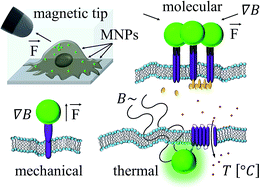当前位置:
X-MOL 学术
›
Chem. Sci.
›
论文详情
Our official English website, www.x-mol.net, welcomes your
feedback! (Note: you will need to create a separate account there.)
Magnetic control of cellular processes using biofunctional nanoparticles
Chemical Science ( IF 7.6 ) Pub Date : 2017-08-09 00:00:00 , DOI: 10.1039/c7sc01462g Cornelia Monzel 1, 2, 3, 4, 5 , Chiara Vicario 1, 2, 3, 4, 5 , Jacob Piehler 6, 7, 8, 9, 10 , Mathieu Coppey 1, 2, 3, 4, 5 , Maxime Dahan 1, 2, 3, 4, 5
Chemical Science ( IF 7.6 ) Pub Date : 2017-08-09 00:00:00 , DOI: 10.1039/c7sc01462g Cornelia Monzel 1, 2, 3, 4, 5 , Chiara Vicario 1, 2, 3, 4, 5 , Jacob Piehler 6, 7, 8, 9, 10 , Mathieu Coppey 1, 2, 3, 4, 5 , Maxime Dahan 1, 2, 3, 4, 5
Affiliation

|
Remote control of cellular functions is a key challenge in biomedical research. Only a few tools are currently capable of manipulating cellular events at distance, at spatial and temporal scales matching their naturally active range. A promising approach, often referred to as ‘magnetogenetics’, is based on the use of magnetic fields, in conjunction with targeted biofunctional magnetic nanoparticles. By triggering molecular stimuli via mechanical, thermal or biochemical perturbations, magnetic actuation constitutes a highly versatile tool with numerous applications in fundamental research as well as exciting prospects in nano- and regenerative medicine. Here, we highlight recent studies, comment on the advancement of magnetic manipulation, and discuss remaining challenges.
中文翻译:

使用生物功能纳米粒子的细胞过程的磁控制
细胞功能的远程控制是生物医学研究中的关键挑战。当前,只有少数工具能够在远距离,与它们的自然活动范围相匹配的时空尺度上操纵细胞事件。一种有前途的方法,通常被称为“磁遗传学”,是基于磁场的使用以及目标生物功能磁性纳米粒子的。通过机械,热或生物化学扰动触发分子刺激,磁致动构成了一种高度通用的工具,在基础研究中具有广泛的应用,在纳米和再生医学领域也具有令人兴奋的前景。在这里,我们重点介绍了最近的研究,对电磁操纵的发展进行了评论,并讨论了仍然存在的挑战。
更新日期:2017-09-15
中文翻译:

使用生物功能纳米粒子的细胞过程的磁控制
细胞功能的远程控制是生物医学研究中的关键挑战。当前,只有少数工具能够在远距离,与它们的自然活动范围相匹配的时空尺度上操纵细胞事件。一种有前途的方法,通常被称为“磁遗传学”,是基于磁场的使用以及目标生物功能磁性纳米粒子的。通过机械,热或生物化学扰动触发分子刺激,磁致动构成了一种高度通用的工具,在基础研究中具有广泛的应用,在纳米和再生医学领域也具有令人兴奋的前景。在这里,我们重点介绍了最近的研究,对电磁操纵的发展进行了评论,并讨论了仍然存在的挑战。









































 京公网安备 11010802027423号
京公网安备 11010802027423号